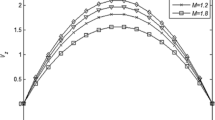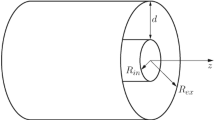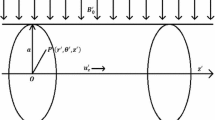Summary
Unsteady circulation of an incompressible fluid of finite conductivity between two infinite concentric cylinders under the influence of a radial magnetic field is considered). Three cases are treated: (1) an external axial electric field is imposed, while the walls remain stationary; (2) and (3) no external electric field is imposed, but the walls either rotate at constant angular velocities, or oscillate sinusoidally. It is shown that none of the variables are dependent upon axial or angular position, and that the radial magnetic field component is independent of the fluid motion. These fortunate circumstances result in a coupled linear system of equations for the fluid velocity and the tangential magnetic field component. They are uncoupled by assuming the induced electric field to be space — independent at every instant. This is exact for steady flows. Zero and first-order approximate solutions may then be obtained either by neglecting the induced electric field, or by satisfying conservation of charge requirements. It is shown that neglect of the induced electric field is permissible only at small Hartmann numbers. An interesting feature of the solution is that the orthogonal expansion is in terms of Bessel functions whose order depends upon the Hartmann number, and hence may be arbitrarily large. Finally, it is thought that the first flow may find application in a novel viscometer for monitoring physical property variations in remote, hazardous, or highly reactive fluid systems. Some numerical examples are presented in support of the feasibility of such a device.
Similar content being viewed by others
Abbreviations
- B, b :
-
magnetic flux vector; gauss, dimensionless
- B 0 :
-
magnetic flux density at outer radius
- C 1,C 2 :
-
constants defined by (2.3.8)
- D :
-
dielectric displacement
- E, e :
-
electric field intensity vector; abvolt/cm, dim.
- e, e i, e0 :
-
total, induced, and external axial electric field components; dim.
- G, g :
-
gravitational acceleration; cm/sec2, dim.
- h :
-
height of co-axial cylinders; cm
- H :
-
magnetic field intensity; oersted
- J, j :
-
current density; abvolt/cm2, dim.
- L :
-
annular gap width; cm
- M H :
-
Hartmann number; dim.
- M 0 :
-
moment on outer cylinder; dyne - cm
- m :
-
order of Bessel functions, defined by (2.3.9)
- N R :
-
Reynolds number
- r :
-
radial co-ordinate in cylindrical system; cm
- R :
-
inside radius of outer cylinder; cm
- R M :
-
magnetic Reynolds number
- s :
-
dimensionless radial co-ordinate
- t :
-
time; sec
- V, ν :
-
velocity vector; cm/sec, dim.
- V 0 :
-
radius average velocity; cm/sec
- Z, z :
-
longitudinal co-ordinate; cm, dim.
- β = 1 - γ:
-
dimensionless inner radius
- Γ, γ :
-
shear stress; dyne/cm2, dim.
- ε :
-
dielectric constant
- ζ i :
-
positive roots of Eq. (A.3)
- η :
-
magnetic diffusivity for momentum, cm2/sec
- θ :
-
azimuthal co-ordinate in cylindrical system; rad
- γ =L/R :
-
dimensionless annular gap width
- μ :
-
magnetic permeability; abhenry/cm
- ν :
-
kinematic viscosity; cm2/sec
- ρ :
-
fluid density; gm/cm3
- σ :
-
fluid conductivity; abmho/cm
- τ :
-
dimensionless time
- r, θ, z :
-
denote components in cylindrical co-ordinates
References
Bickley, W. G. and J. C. P. Miller, Phil. Mag.34 (1943) 35.
Bird, R. B. and C. F. Curtiss, Chem. Engrg. Sci.11 (1959) 108.
Chang, C. C. and T. S. Lundgren, Z. angew. Math. Phys.12 (1961) 100.
Chang, C. C. and J. T. Yen, Phys. Fluids2 (1959) 393.
Chekmarev, I. B., Scientific-Tech. Information Bul. no. 8, Leningrad Polytech. Inst., Radzdel fiz.-mat. nauk., 1959.
Cowling, T. G., Magnetohydrodynamics, Interscience, New York, 1957.
Globe, S., Phys. Fluids2 (1959) 404.
Globe, S., Phys. Fluids3 (1960) 665.
Gold, R. R., J. Fluid Mech.13 (1962) 505.
Hartmann, J., Kgl. Danske Videnskab. Selskab, Mat. — fys. Medd.15 (1937) 1.
Irving, J. and N. Mullineux, Mathematics in Physics and Engineering, Academic Press, New York, 1959.
Kapur, J. N. and R. K. Jain, Phys. Fluids3 (1960) 664.
Lehnert, B., Ark. Fys.5 (1952) 69.
Lundgren, T. S., B. H. Atabek and C. C. Chang, Phys. Fluids4 (1961) 1006.
McMahon, J., Annals Math.9 (1894) 23.
Nirenberg, L., Comm. Pure Appl. Math.6 (1953) 167.
Ramamoorthy, P., Phys. Fluids4 (1961) 1444.
Shercliff, J. A., Proc. Camb. Phil. Soc.49 (1953) 136.
Shercliff, J. A., J. Fluid Mech.1 (1956) 644.
Shercliff, J. A., J. Fluid Mech.13 (1962) 513.
Sneddon, I. N., Fourier Transforms. pp. 71–91, 302–7, McGraw-Hill, New York, 1951.
Tao, L. N., J. Aero/Space Sci.27 (1960) 334.
Taylor, G. I., Phil Trans.A 233 (1923) 289.
Watson, J., Theory of Bessel Functions. 2nd ed., Cambridge: University Press, 1944.
Author information
Authors and Affiliations
Rights and permissions
About this article
Cite this article
Moynihan, D.C., Bankoff, S.G. Magnetohydrodynamic circulation of a liquid of finite conductivity in an annulus. Appl. Sci. Res. 12, 165–202 (1965). https://doi.org/10.1007/BF00382119
Received:
Issue Date:
DOI: https://doi.org/10.1007/BF00382119




